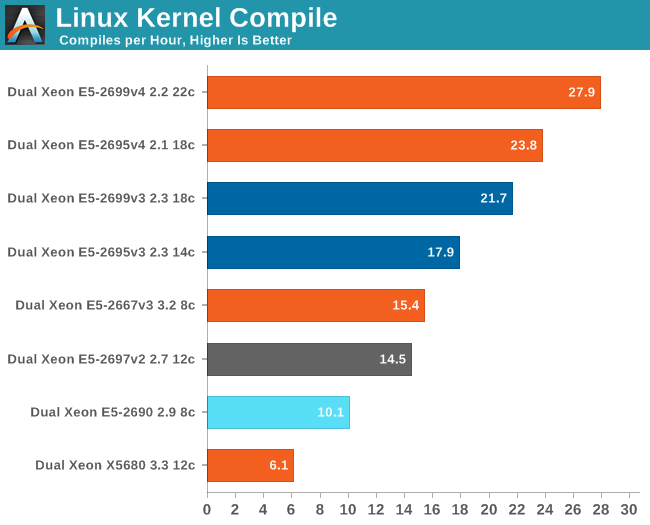The Intel Xeon E5 v4 Review: Testing Broadwell-EP With Demanding Server Workloads
by Johan De Gelas on March 31, 2016 12:30 PM EST- Posted in
- CPUs
- Intel
- Xeon
- Enterprise
- Enterprise CPUs
- Broadwell
Application Development: Linux Kernel Compile
A more real world benchmark to test the integer processing power of our Xeon servers is a Linux kernel compile. Although few people compile their own kernel, compiling other software on servers is a common task and this will give us a good idea of how the CPUs handle a complex build.
To do this we have downloaded the 3.11 kernel from kernel.org. We then compiled the kernel with the "time make -jx" command, where x is the maximum number of threads that the platform is capable of using. To make the graph more readable, the number of seconds in wall time was converted into the number of builds per hour.

A kernel compile does not scale perfectly with more cores, but the Xeon E5-2699 v4 offers up to 2.7 times better performance than the Xeon it is supposed to replace. This kind of workload really seems to favor the new Broadwell core: even at slightly lower clockspeeds, the 18 core Xeon E5-2695 v4 beats the v3 version with the same number of cores by 9%.










112 Comments
View All Comments
Kevin G - Thursday, March 31, 2016 - link
Much like how Apple skipped Haswell-EP, they also skipped a generation of cards from AMD and nVidia. So even if Apple doesn't wait for new GPUs, their is certainly an update on the GPU side.The more interesting possibility would be if Apple were to go with Xeon D in the Mac Pro instead of Broadwell-EP. Apple would need a big PLX chip considering the number of lanes they's want to use but it is possible.
bill.rookard - Thursday, March 31, 2016 - link
Another issue is that they're not under any pressure from any competition to really innovate. I don't even remember the last time I read anything about Opteron servers... let alone something about any NEW Opterons.ComputerGuy2006 - Thursday, March 31, 2016 - link
A sign of things to come for Broadwell-e?Seems like a tricky situation. Because skylake-e will come with a new platform in 2017, while broadwell-e isn't the fastest IPC and there are crazy rumors it will might cost $1500 (lol Intel). We also have Zen later this year that might give good performance with good cost/perf ratio.
extide - Thursday, March 31, 2016 - link
Yeah so Intel only gives us the LCC part for the -E platform, so we will see the 10-core SKU as the top, It will either be $1000, or $1500 ... so yeah not sure how that will end up. Although there will be 8 and 6 core options that should be pretty affordable.Hopefully they do an 8 core part with 28 lanes for under $500, as THAT would be a great deal!
dragonsqrrl - Sunday, April 3, 2016 - link
I'm hoping the 8 core SKU is around $600, the position the x930K traditionally occupies. What makes me a little worried is that there will be 4 SKUs instead of 3 this time (one 10 core, one 8 core, and two 6 core), and I'm not sure there's enough room under the $600 price point for two 6 core processors.jasonelmore - Thursday, March 31, 2016 - link
Can it run Star Citizen?theduckofdeath - Thursday, March 31, 2016 - link
A question we'll never get an answer to? :DJohanAnandtech - Friday, April 1, 2016 - link
It probably runs mostly on Xeons. Well, the back end that is :-)extide - Thursday, March 31, 2016 - link
BOOM, 454mm^2 on the worlds best process. The "other" 14/16nm processes use bigger geometry than Intel's 14nm process.Now we just need those other guys to catch up so we can see 450+mm GPU's!
Kevin G - Thursday, March 31, 2016 - link
Intel still has plenty of room to increase die size. The largest chip they've produced was the Tukwila Itanium 2 at 699 mm^2. Granted that was a 65 nm design but Haswell-EX is a juggarnaught at 662 mm^2 on Intel's more recent 22 nm process. Seems reasonable that SkyLake-EX could go to 32 cores as Intel has >200 mm^2 of rectal limit left.As for GPU's, they're also huge. nVidia's GM200 is 601 mm^2 and AMD's Fiji is 'only' 596 mm^2 both on 28 nm process. TSMC's 20 nm process was skipped so even using the looser 16 nm FinFET, GPU's will see a significant shrink compared to the those high end chips.